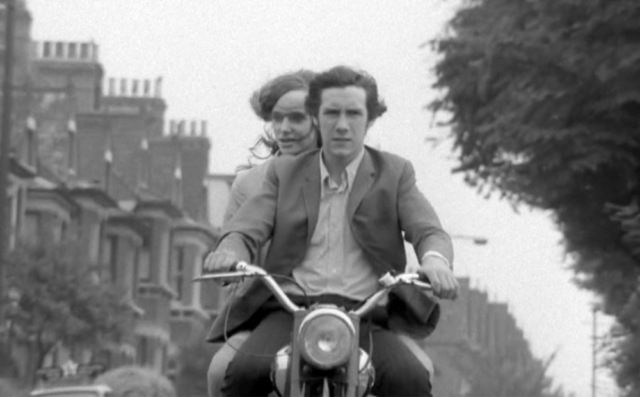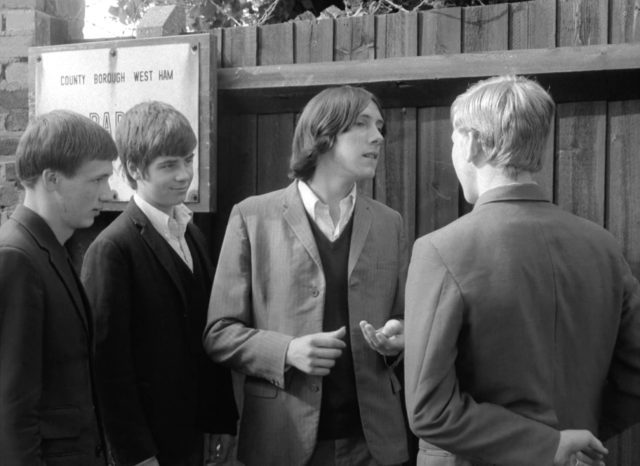
Del (Del Walker) takes Irene (Anne Gooding) on a ride to nowhere in Bronco Bullfrog
BRONCO BULLFROG (Barney Platts-Mills, 1969)
Film Forum
209 West Houston St.
March 25-31
212-727-8110
filmforum.org
It’s a shame that writer-director Barney Platts-Mills won’t be around for the US theatrical premiere of the 2K restoration of his remarkable, long-forgotten 1970 underground black-and-white cult favorite, Bronco Bullfrog. But the British auteur, who passed away in October at the age of seventy-six, did supervise the restoration, and the film’s cinematographer, Adam Barker-Mill, will be at the 7:00 show at Film Forum on opening night, March 25, to talk about the making of the kitchen sink drama, the British neorealist subgenre that included such works as Tony Richardson’s Look Back in Anger, Ken Loach’s Kes, and Jack Clayton’s Room at the Top.
The story takes place in the shabby East End of London, where a group of boys battle malaise and boredom by sneaking into the movies, pulling off petty robberies, and fighting a gang of well-dressed, better-educated guys led by Parker (J. Hughes Jr.). Del Quant (Del Walker) is a seventeen-year-old welding apprentice who hangs around with his ne’er-do-well buddies, Roy (Roy Haywood), Chris (Chris Shepherd), and Geoff (Geoffrey Wincott). When Del meets Chris’s cousin, Tina (Tina Syer), and her fifteen-year-old friend, Irene Richardson (Anne Gooding), Del and Irene start seeing each other, but with little money they don’t exactly go out on the town; sometimes they merely head to the group’s hideout, a ramshackle space with dirty words and magazine pictures of naked women on the walls.
When local legend Jo Saville (Sam Shepherd), also known as Bronco Bullfrog, gets out of reform school, he offers Del a chance to make some fast cash, but they’re not exactly a crackerjack bunch of thieves; Jo, Del, Roy, and Chris are not even the droogs from Stanley Kubrick’s A Clockwork Orange, which came out the following year. In fact, the films have several elements in common; perhaps Platts-Mills was familiar with Anthony Burgess’s 1962 novel. Like Clockwork, Bronco Bullfrog has its own language and features heavy accents, so subtitles are often used, which has also been the case with many of Loach’s films. (In Platts-Mills’s second film, the more free-wheeling Private Road, the protagonists go to see Kubrick’s Spartacus.)
Neither Del’s father (Dick Philpott) nor Irene’s mother (Freda Shepherd) is happy about the kids’ relationship, especially when Sergeant Johnson (Stuart Stones) shows an interest in Del. But Del and Irene keep doing their thing, not talking or doing much as they try to figure out if there’s anything out there in the world for them; they know what they don’t want but not what they do, their lives devoid of the promise of a happy future while they seek out instant, temporary kicks.
Bronco Bullfrog is a wonderfully drawn study of teen angst and ennui. The characters wander aimlessly through empty, decrepit streets and alleys, every turn leading nowhere. Much of the poetic and deeply romantic film is improvised and shot on location where the nonprofessional actors live; it was made for a mere eighteen thousand pounds. Platts-Mills himself ran away from his expensive public school when he was fifteen; his father, John Platts-Mills, was a prominent barrister and member of Parliament.
The idea for the film came from Walker and his friends, who had participated in theater director Joan Littlewood’s workshop at the Play Barn, which was depicted in Platts-Mills’s 1969 documentary, Everybody’s an Actor, Shakespeare Said. They needed something to do, so Walker asked the director to make a movie with them.

Four East End teens battle malaise in Barney Platts-Mills’s Bronco Bullfrog
Although there was a script, the disenfranchised youth, neither mods nor rockers, just go about a fictionalized version of their lives, making it up on the fly as Platts-Mills and Barker-Mill — who became a successful installation artist — keep the cameras rolling. The charmless Del fancies himself a ladies’ man, but the scene in which he meets Irene is hysterical. He and Chris sit opposite Irene and Tina in a small tea shop, with nothing to say; Roy, playing pinball, looks over as if he’s jealous that his pals are talking to girls, but he’s not ready for that either and goes back to his game. On another date, Del, who recently bought a used motorbike, sits with Irene outside the fence of a motocross race, watching the kind of excitement that never comes his way.
Meanwhile, Bronco Bullfrog is no tough gang leader; he’s a bit of a doofus and maybe even just a nice guy who’s lost, which is perhaps why Platts-Mills named the film after him, because he’s a relatively minor character. He’s so thoughtful and gentle with his landlady (E. E. Blundell) that it’s easy to see through his supposed tough exterior. And the battles with Parker and his friends are pathetic; after Del and his group lamely push one of them to the ground, they later brag about how they beat him up.
The 2K restoration, made from the original 35mm print that was saved out of the garbage, is stark and sharp, capturing the feel of the teens’ mundane existence in this downtrodden corner of British society. The soundtrack is by drummer Tony Connor, saxophonist Keith Gemmell, bassist Trevor Williams, and guitarist Howard Werth of the British art-rock band Audience, adding to the late-1960s vibe. The multi-award-winning Platts-Mills went on to make the 1982 sword and sorcery film Hero and the 2010 drama Zohra: A Moroccan Fairy Tale, also about teen lovers. But it all started with Bronco Bullfrog, a landmark of British cinema that is finally getting its due here in America.